RMIT Psychology: Social Connectedness, Stress, and Conscientiousness
VerifiedAdded on 2023/06/07
|17
|2878
|94
Report
AI Summary
This report investigates the relationship between social connectedness, conscientiousness, and student wellbeing, specifically focusing on first-year psychology students at RMIT University. The study examines how these factors influence psychological stress during the transition to tertiary studies. Data was collected through online questionnaires, and statistical analysis was performed using SPSS to determine the correlation between the variables. The results indicate a negative relationship between both conscientiousness and social connectedness with student stress, suggesting that higher levels of conscientiousness and social connectedness are associated with reduced stress. The report discusses the implications of these findings, relating them to existing research and offering recommendations for students to improve their academic performance and wellbeing. Desklib provides access to this report and many other solved assignments for students.
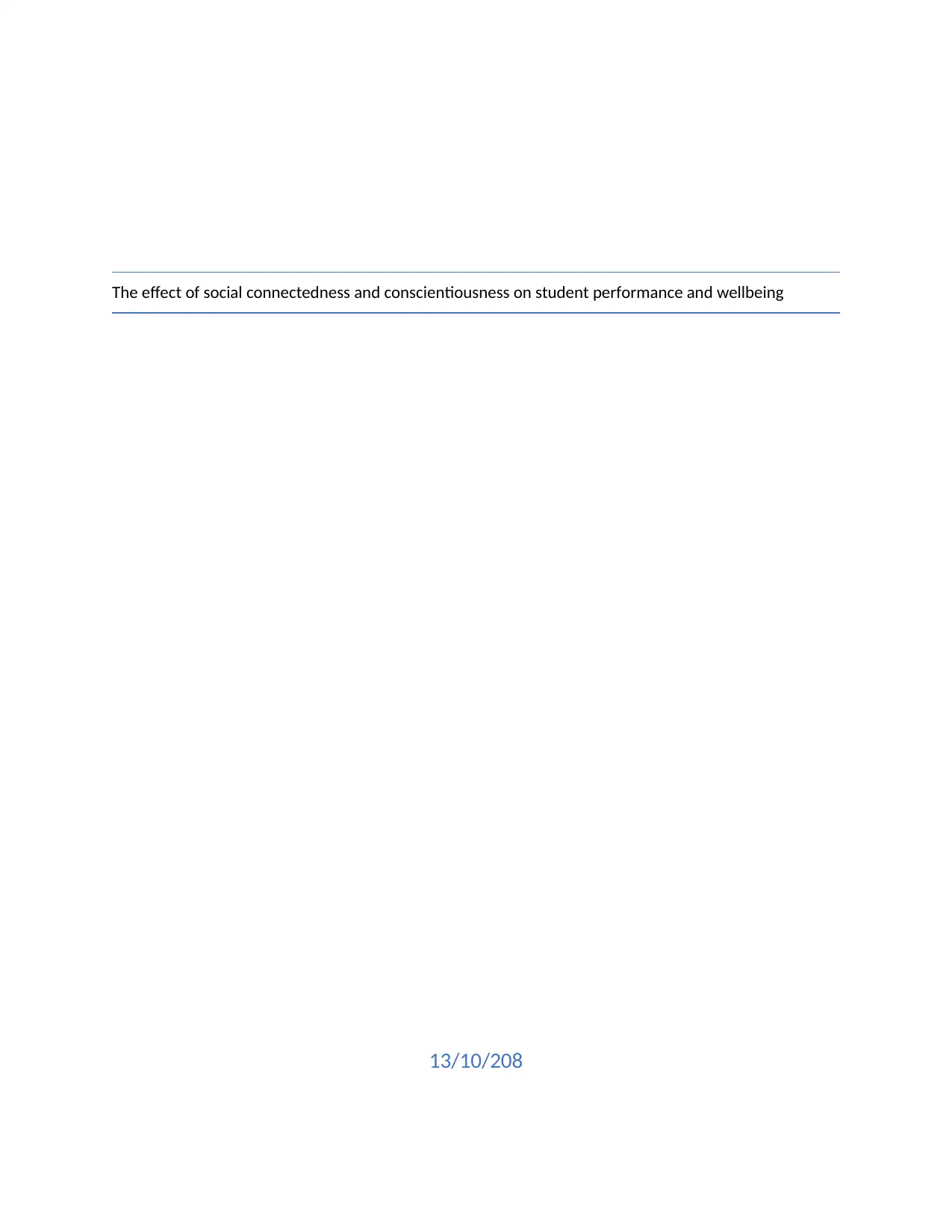
The effect of social connectedness and conscientiousness on student performance and wellbeing
13/10/208
13/10/208
Paraphrase This Document
Need a fresh take? Get an instant paraphrase of this document with our AI Paraphraser
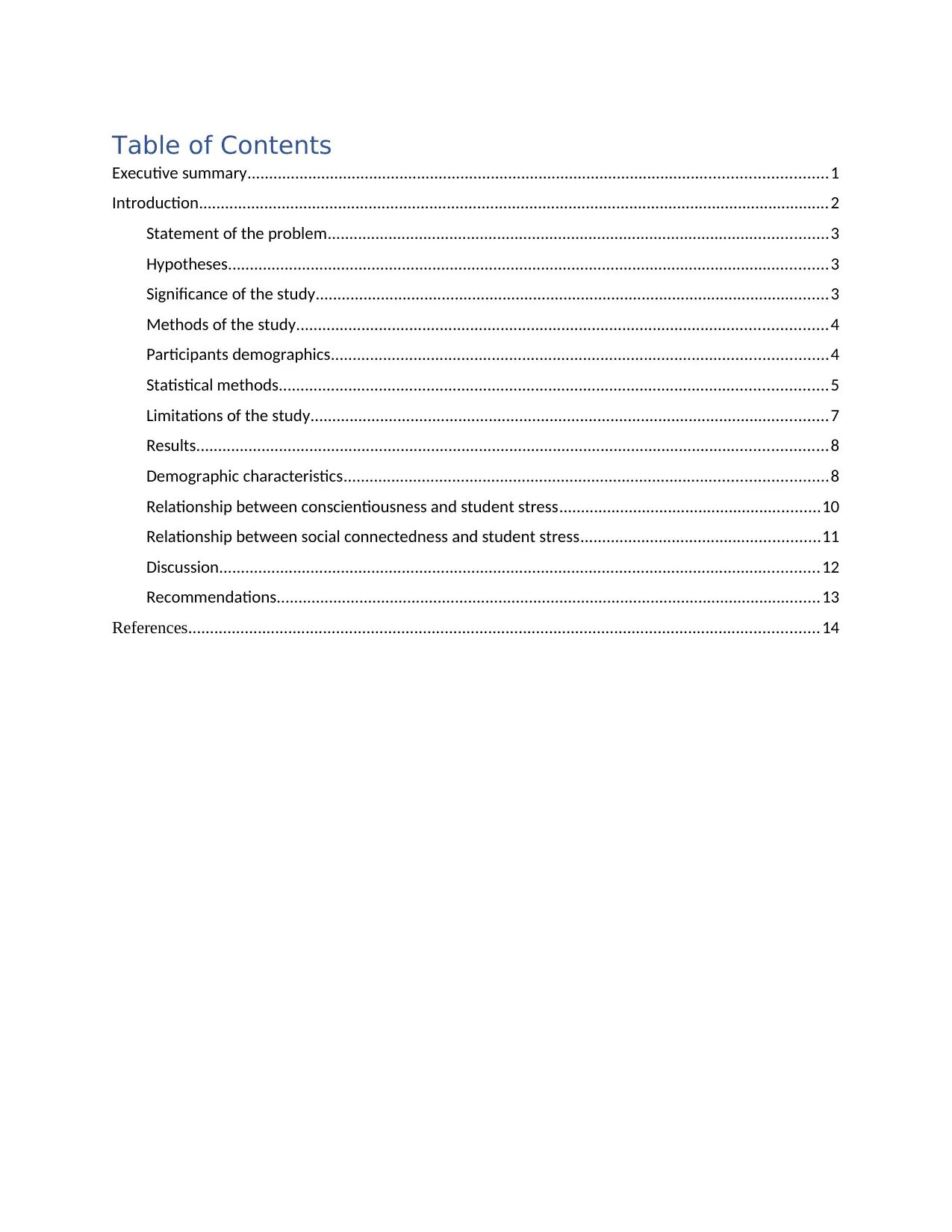
Table of Contents
Executive summary.....................................................................................................................................1
Introduction.................................................................................................................................................2
Statement of the problem...................................................................................................................3
Hypotheses..........................................................................................................................................3
Significance of the study......................................................................................................................3
Methods of the study..........................................................................................................................4
Participants demographics..................................................................................................................4
Statistical methods..............................................................................................................................5
Limitations of the study.......................................................................................................................7
Results.................................................................................................................................................8
Demographic characteristics...............................................................................................................8
Relationship between conscientiousness and student stress............................................................10
Relationship between social connectedness and student stress.......................................................11
Discussion..........................................................................................................................................12
Recommendations.............................................................................................................................13
References.................................................................................................................................................14
Executive summary.....................................................................................................................................1
Introduction.................................................................................................................................................2
Statement of the problem...................................................................................................................3
Hypotheses..........................................................................................................................................3
Significance of the study......................................................................................................................3
Methods of the study..........................................................................................................................4
Participants demographics..................................................................................................................4
Statistical methods..............................................................................................................................5
Limitations of the study.......................................................................................................................7
Results.................................................................................................................................................8
Demographic characteristics...............................................................................................................8
Relationship between conscientiousness and student stress............................................................10
Relationship between social connectedness and student stress.......................................................11
Discussion..........................................................................................................................................12
Recommendations.............................................................................................................................13
References.................................................................................................................................................14
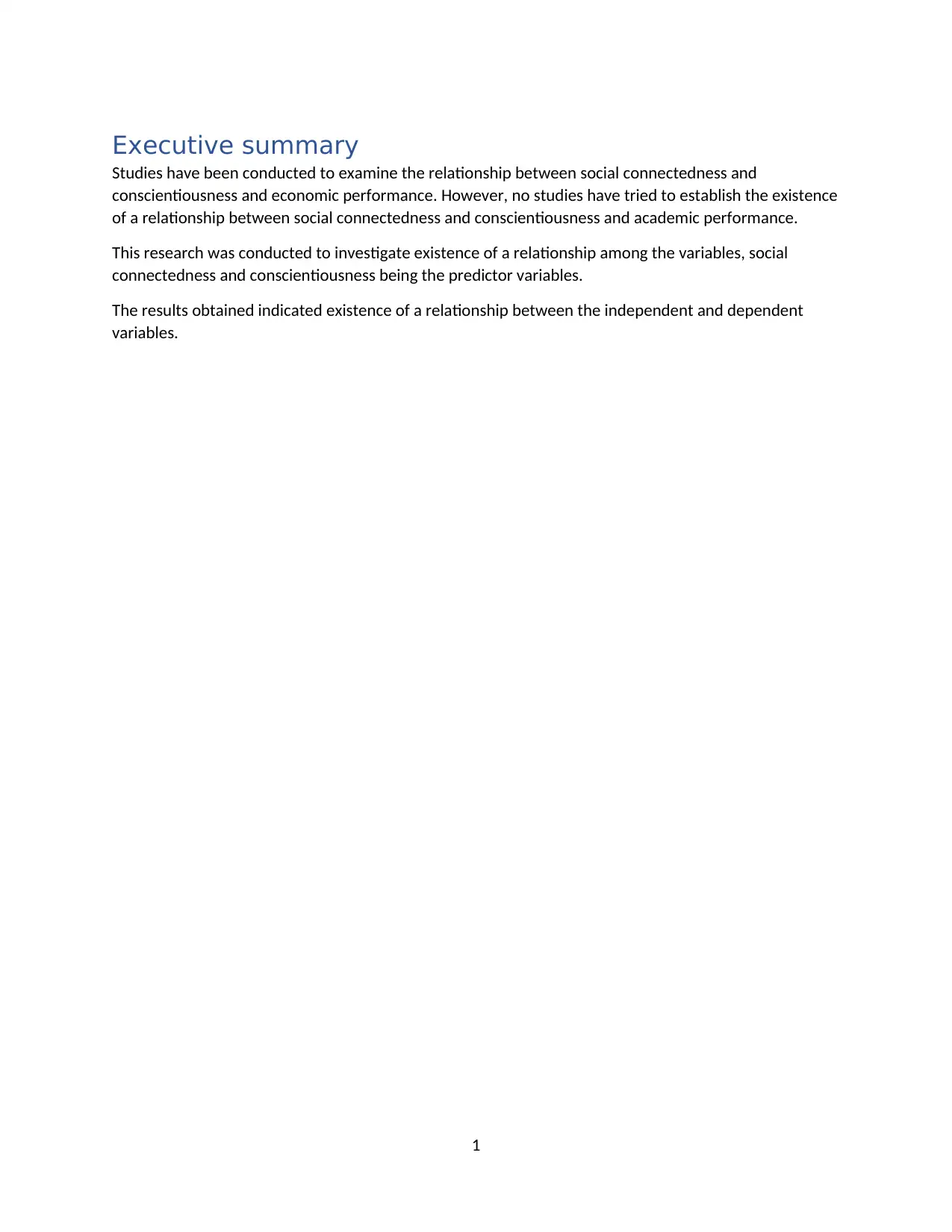
Executive summary
Studies have been conducted to examine the relationship between social connectedness and
conscientiousness and economic performance. However, no studies have tried to establish the existence
of a relationship between social connectedness and conscientiousness and academic performance.
This research was conducted to investigate existence of a relationship among the variables, social
connectedness and conscientiousness being the predictor variables.
The results obtained indicated existence of a relationship between the independent and dependent
variables.
1
Studies have been conducted to examine the relationship between social connectedness and
conscientiousness and economic performance. However, no studies have tried to establish the existence
of a relationship between social connectedness and conscientiousness and academic performance.
This research was conducted to investigate existence of a relationship among the variables, social
connectedness and conscientiousness being the predictor variables.
The results obtained indicated existence of a relationship between the independent and dependent
variables.
1
⊘ This is a preview!⊘
Do you want full access?
Subscribe today to unlock all pages.

Trusted by 1+ million students worldwide
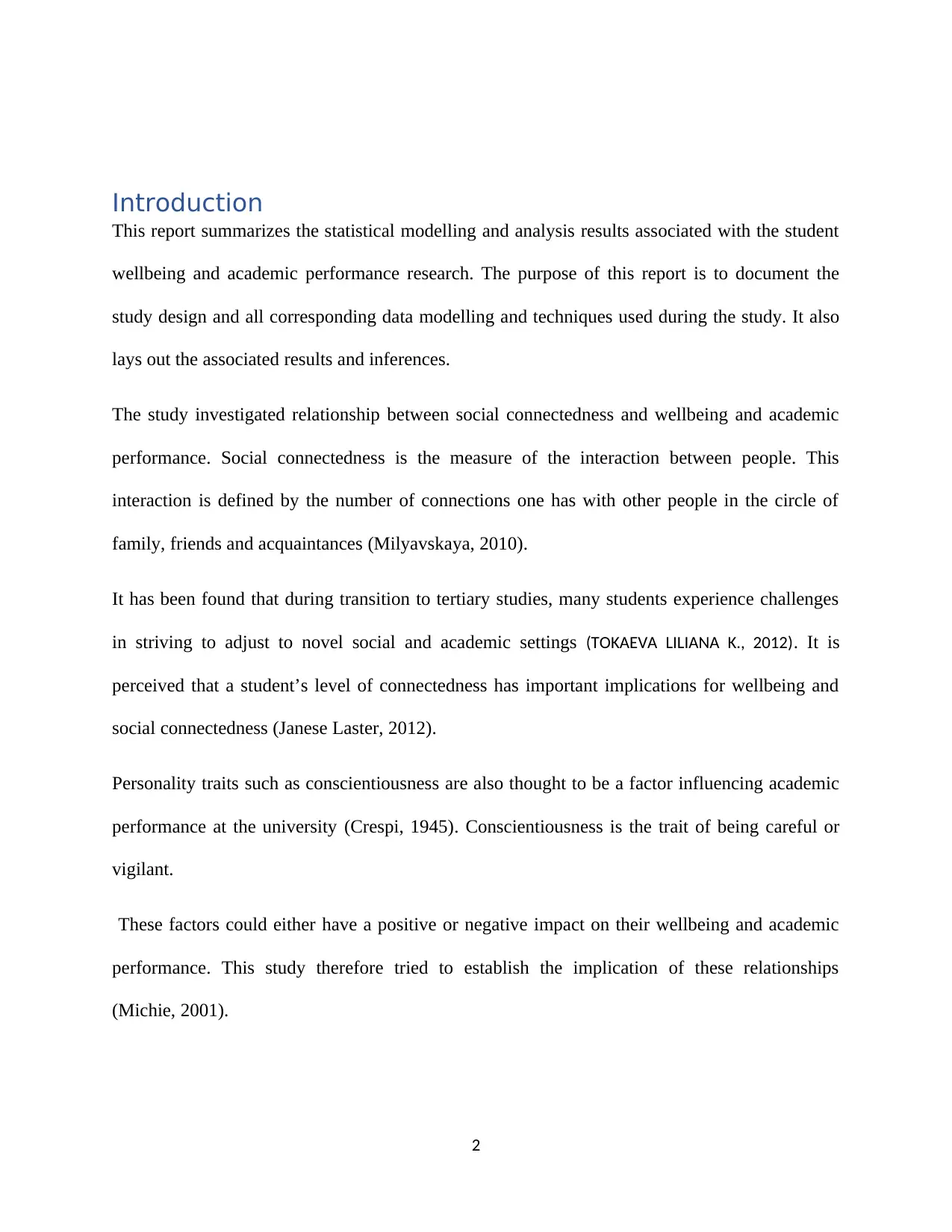
Introduction
This report summarizes the statistical modelling and analysis results associated with the student
wellbeing and academic performance research. The purpose of this report is to document the
study design and all corresponding data modelling and techniques used during the study. It also
lays out the associated results and inferences.
The study investigated relationship between social connectedness and wellbeing and academic
performance. Social connectedness is the measure of the interaction between people. This
interaction is defined by the number of connections one has with other people in the circle of
family, friends and acquaintances (Milyavskaya, 2010).
It has been found that during transition to tertiary studies, many students experience challenges
in striving to adjust to novel social and academic settings (TOKAEVA LILIANA K., 2012). It is
perceived that a student’s level of connectedness has important implications for wellbeing and
social connectedness (Janese Laster, 2012).
Personality traits such as conscientiousness are also thought to be a factor influencing academic
performance at the university (Crespi, 1945). Conscientiousness is the trait of being careful or
vigilant.
These factors could either have a positive or negative impact on their wellbeing and academic
performance. This study therefore tried to establish the implication of these relationships
(Michie, 2001).
2
This report summarizes the statistical modelling and analysis results associated with the student
wellbeing and academic performance research. The purpose of this report is to document the
study design and all corresponding data modelling and techniques used during the study. It also
lays out the associated results and inferences.
The study investigated relationship between social connectedness and wellbeing and academic
performance. Social connectedness is the measure of the interaction between people. This
interaction is defined by the number of connections one has with other people in the circle of
family, friends and acquaintances (Milyavskaya, 2010).
It has been found that during transition to tertiary studies, many students experience challenges
in striving to adjust to novel social and academic settings (TOKAEVA LILIANA K., 2012). It is
perceived that a student’s level of connectedness has important implications for wellbeing and
social connectedness (Janese Laster, 2012).
Personality traits such as conscientiousness are also thought to be a factor influencing academic
performance at the university (Crespi, 1945). Conscientiousness is the trait of being careful or
vigilant.
These factors could either have a positive or negative impact on their wellbeing and academic
performance. This study therefore tried to establish the implication of these relationships
(Michie, 2001).
2
Paraphrase This Document
Need a fresh take? Get an instant paraphrase of this document with our AI Paraphraser
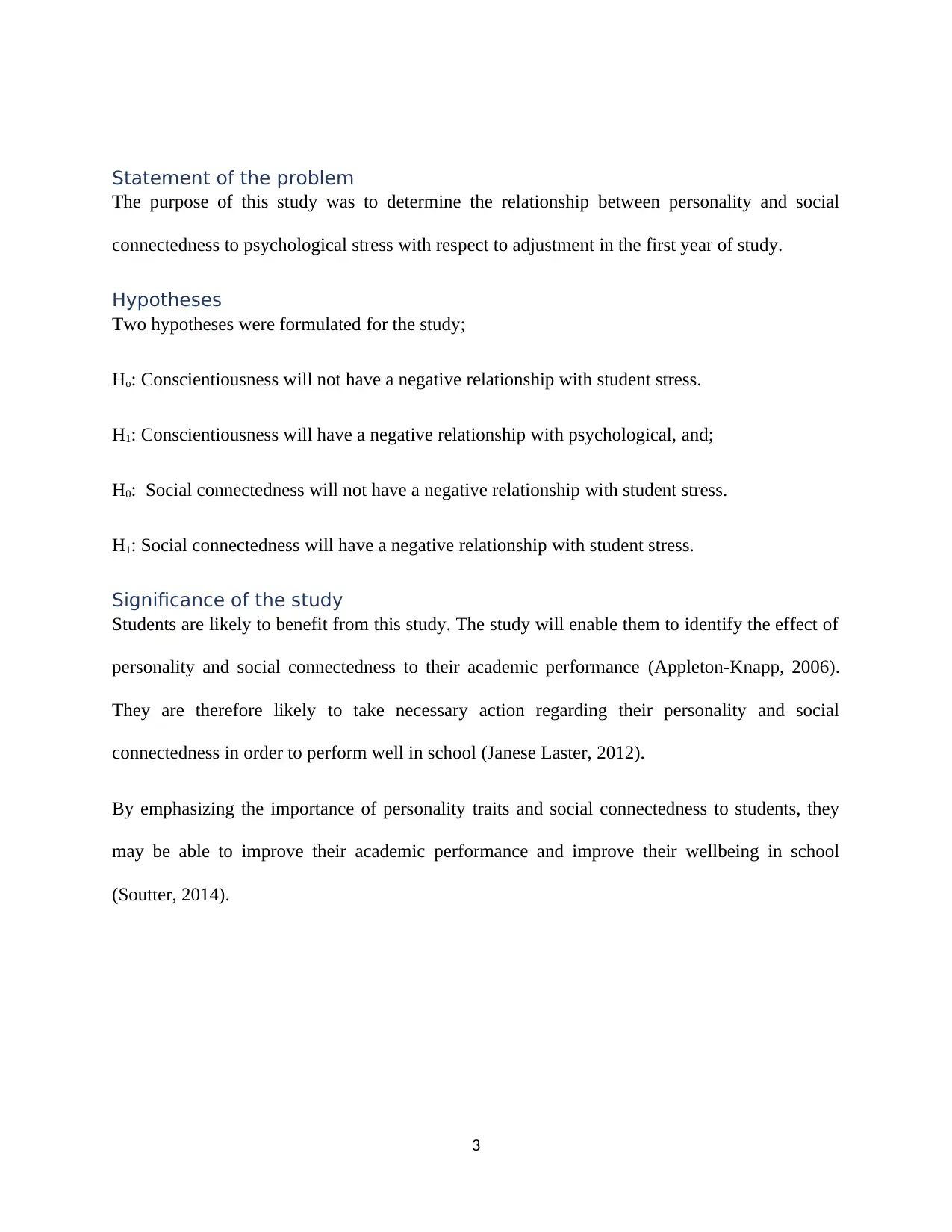
Statement of the problem
The purpose of this study was to determine the relationship between personality and social
connectedness to psychological stress with respect to adjustment in the first year of study.
Hypotheses
Two hypotheses were formulated for the study;
Ho: Conscientiousness will not have a negative relationship with student stress.
H1: Conscientiousness will have a negative relationship with psychological, and;
H0: Social connectedness will not have a negative relationship with student stress.
H1: Social connectedness will have a negative relationship with student stress.
Significance of the study
Students are likely to benefit from this study. The study will enable them to identify the effect of
personality and social connectedness to their academic performance (Appleton-Knapp, 2006).
They are therefore likely to take necessary action regarding their personality and social
connectedness in order to perform well in school (Janese Laster, 2012).
By emphasizing the importance of personality traits and social connectedness to students, they
may be able to improve their academic performance and improve their wellbeing in school
(Soutter, 2014).
3
The purpose of this study was to determine the relationship between personality and social
connectedness to psychological stress with respect to adjustment in the first year of study.
Hypotheses
Two hypotheses were formulated for the study;
Ho: Conscientiousness will not have a negative relationship with student stress.
H1: Conscientiousness will have a negative relationship with psychological, and;
H0: Social connectedness will not have a negative relationship with student stress.
H1: Social connectedness will have a negative relationship with student stress.
Significance of the study
Students are likely to benefit from this study. The study will enable them to identify the effect of
personality and social connectedness to their academic performance (Appleton-Knapp, 2006).
They are therefore likely to take necessary action regarding their personality and social
connectedness in order to perform well in school (Janese Laster, 2012).
By emphasizing the importance of personality traits and social connectedness to students, they
may be able to improve their academic performance and improve their wellbeing in school
(Soutter, 2014).
3
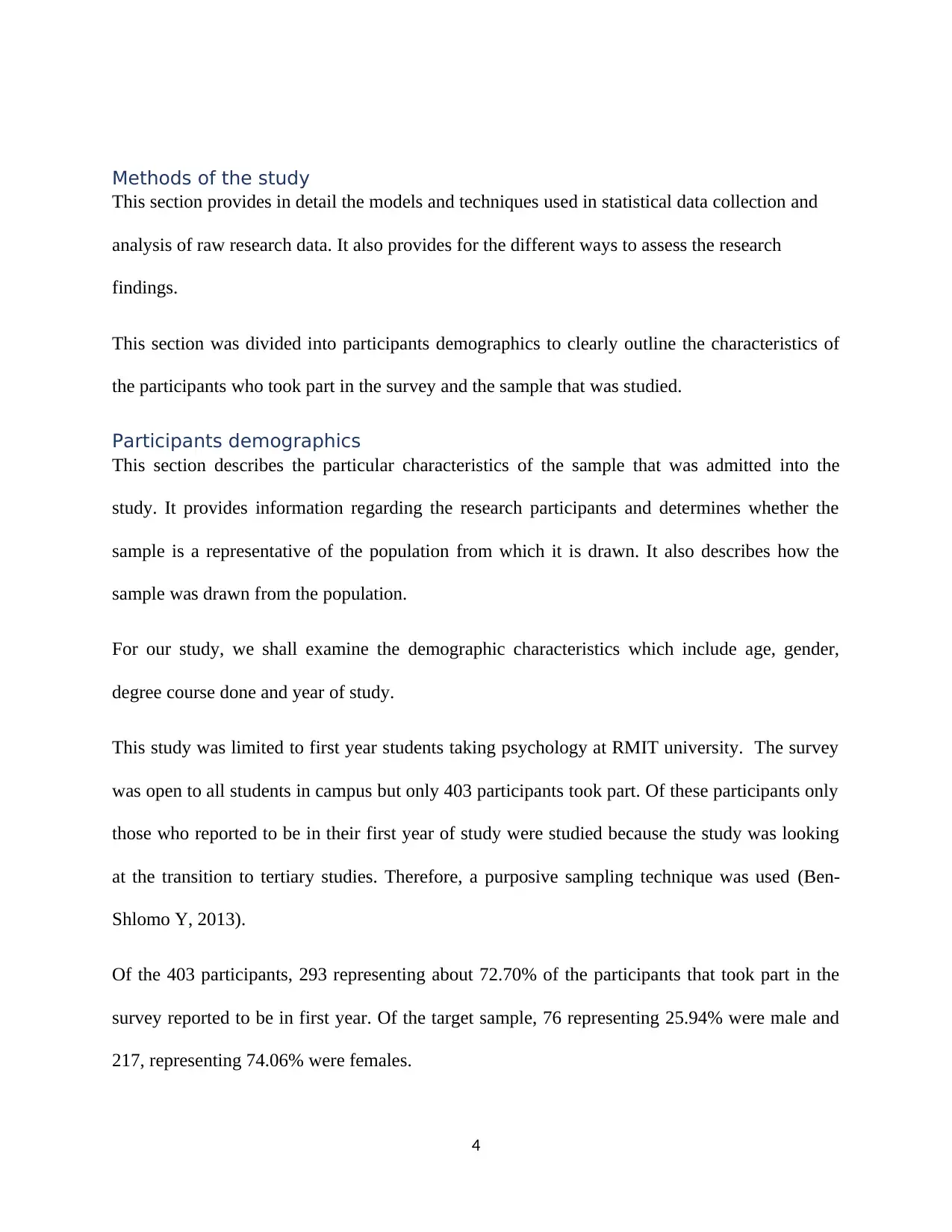
Methods of the study
This section provides in detail the models and techniques used in statistical data collection and
analysis of raw research data. It also provides for the different ways to assess the research
findings.
This section was divided into participants demographics to clearly outline the characteristics of
the participants who took part in the survey and the sample that was studied.
Participants demographics
This section describes the particular characteristics of the sample that was admitted into the
study. It provides information regarding the research participants and determines whether the
sample is a representative of the population from which it is drawn. It also describes how the
sample was drawn from the population.
For our study, we shall examine the demographic characteristics which include age, gender,
degree course done and year of study.
This study was limited to first year students taking psychology at RMIT university. The survey
was open to all students in campus but only 403 participants took part. Of these participants only
those who reported to be in their first year of study were studied because the study was looking
at the transition to tertiary studies. Therefore, a purposive sampling technique was used (Ben-
Shlomo Y, 2013).
Of the 403 participants, 293 representing about 72.70% of the participants that took part in the
survey reported to be in first year. Of the target sample, 76 representing 25.94% were male and
217, representing 74.06% were females.
4
This section provides in detail the models and techniques used in statistical data collection and
analysis of raw research data. It also provides for the different ways to assess the research
findings.
This section was divided into participants demographics to clearly outline the characteristics of
the participants who took part in the survey and the sample that was studied.
Participants demographics
This section describes the particular characteristics of the sample that was admitted into the
study. It provides information regarding the research participants and determines whether the
sample is a representative of the population from which it is drawn. It also describes how the
sample was drawn from the population.
For our study, we shall examine the demographic characteristics which include age, gender,
degree course done and year of study.
This study was limited to first year students taking psychology at RMIT university. The survey
was open to all students in campus but only 403 participants took part. Of these participants only
those who reported to be in their first year of study were studied because the study was looking
at the transition to tertiary studies. Therefore, a purposive sampling technique was used (Ben-
Shlomo Y, 2013).
Of the 403 participants, 293 representing about 72.70% of the participants that took part in the
survey reported to be in first year. Of the target sample, 76 representing 25.94% were male and
217, representing 74.06% were females.
4
⊘ This is a preview!⊘
Do you want full access?
Subscribe today to unlock all pages.

Trusted by 1+ million students worldwide
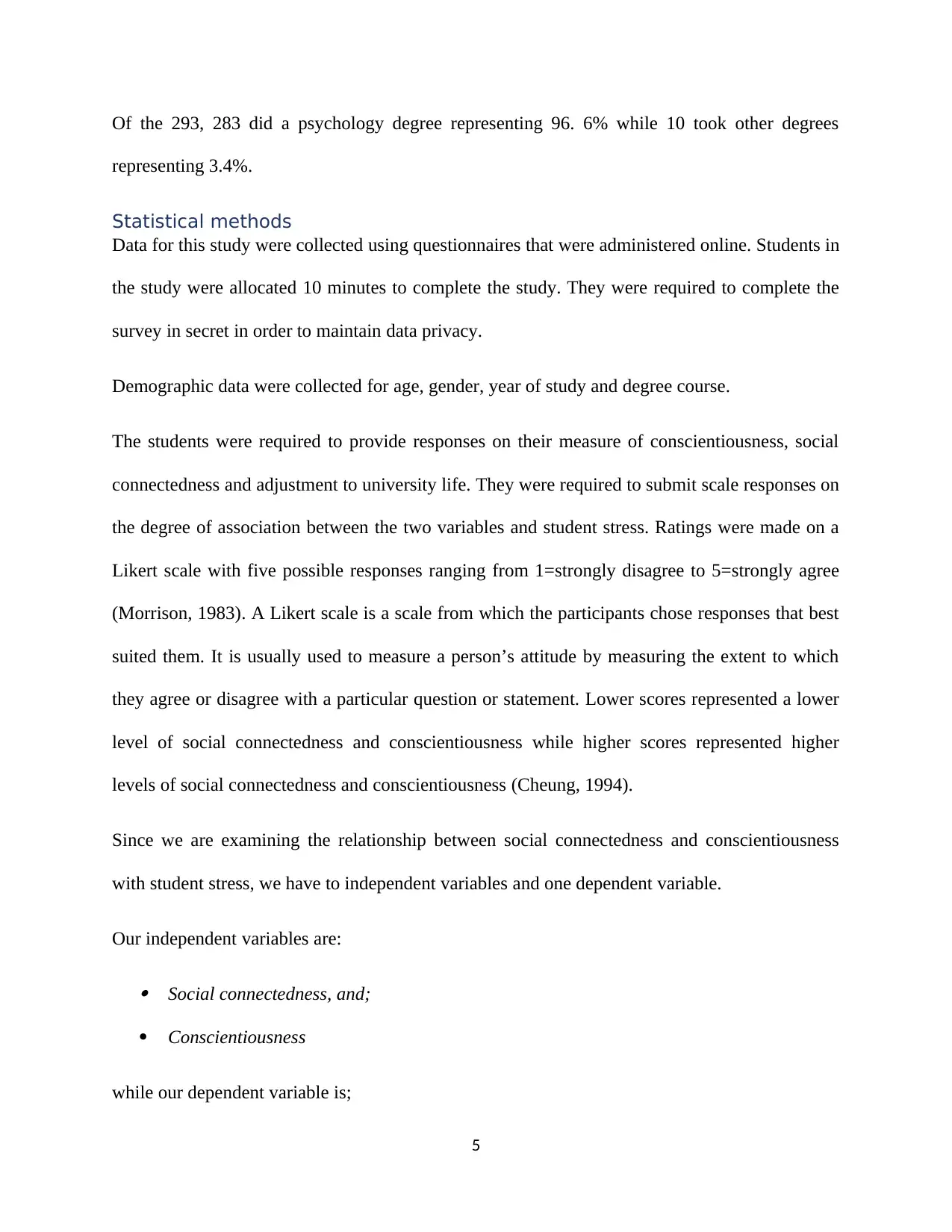
Of the 293, 283 did a psychology degree representing 96. 6% while 10 took other degrees
representing 3.4%.
Statistical methods
Data for this study were collected using questionnaires that were administered online. Students in
the study were allocated 10 minutes to complete the study. They were required to complete the
survey in secret in order to maintain data privacy.
Demographic data were collected for age, gender, year of study and degree course.
The students were required to provide responses on their measure of conscientiousness, social
connectedness and adjustment to university life. They were required to submit scale responses on
the degree of association between the two variables and student stress. Ratings were made on a
Likert scale with five possible responses ranging from 1=strongly disagree to 5=strongly agree
(Morrison, 1983). A Likert scale is a scale from which the participants chose responses that best
suited them. It is usually used to measure a person’s attitude by measuring the extent to which
they agree or disagree with a particular question or statement. Lower scores represented a lower
level of social connectedness and conscientiousness while higher scores represented higher
levels of social connectedness and conscientiousness (Cheung, 1994).
Since we are examining the relationship between social connectedness and conscientiousness
with student stress, we have to independent variables and one dependent variable.
Our independent variables are:
Social connectedness, and;
Conscientiousness
while our dependent variable is;
5
representing 3.4%.
Statistical methods
Data for this study were collected using questionnaires that were administered online. Students in
the study were allocated 10 minutes to complete the study. They were required to complete the
survey in secret in order to maintain data privacy.
Demographic data were collected for age, gender, year of study and degree course.
The students were required to provide responses on their measure of conscientiousness, social
connectedness and adjustment to university life. They were required to submit scale responses on
the degree of association between the two variables and student stress. Ratings were made on a
Likert scale with five possible responses ranging from 1=strongly disagree to 5=strongly agree
(Morrison, 1983). A Likert scale is a scale from which the participants chose responses that best
suited them. It is usually used to measure a person’s attitude by measuring the extent to which
they agree or disagree with a particular question or statement. Lower scores represented a lower
level of social connectedness and conscientiousness while higher scores represented higher
levels of social connectedness and conscientiousness (Cheung, 1994).
Since we are examining the relationship between social connectedness and conscientiousness
with student stress, we have to independent variables and one dependent variable.
Our independent variables are:
Social connectedness, and;
Conscientiousness
while our dependent variable is;
5
Paraphrase This Document
Need a fresh take? Get an instant paraphrase of this document with our AI Paraphraser
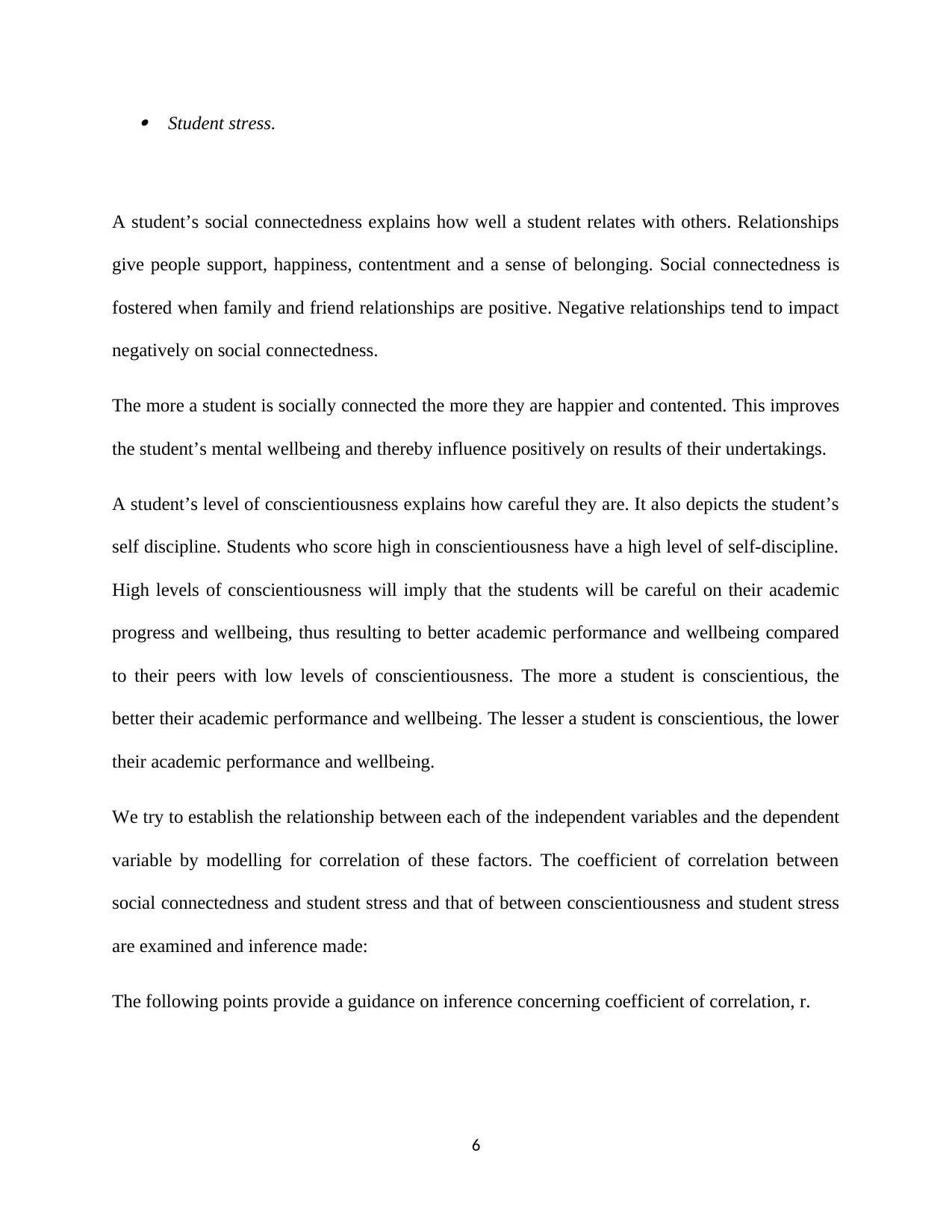
Student stress.
A student’s social connectedness explains how well a student relates with others. Relationships
give people support, happiness, contentment and a sense of belonging. Social connectedness is
fostered when family and friend relationships are positive. Negative relationships tend to impact
negatively on social connectedness.
The more a student is socially connected the more they are happier and contented. This improves
the student’s mental wellbeing and thereby influence positively on results of their undertakings.
A student’s level of conscientiousness explains how careful they are. It also depicts the student’s
self discipline. Students who score high in conscientiousness have a high level of self-discipline.
High levels of conscientiousness will imply that the students will be careful on their academic
progress and wellbeing, thus resulting to better academic performance and wellbeing compared
to their peers with low levels of conscientiousness. The more a student is conscientious, the
better their academic performance and wellbeing. The lesser a student is conscientious, the lower
their academic performance and wellbeing.
We try to establish the relationship between each of the independent variables and the dependent
variable by modelling for correlation of these factors. The coefficient of correlation between
social connectedness and student stress and that of between conscientiousness and student stress
are examined and inference made:
The following points provide a guidance on inference concerning coefficient of correlation, r.
6
A student’s social connectedness explains how well a student relates with others. Relationships
give people support, happiness, contentment and a sense of belonging. Social connectedness is
fostered when family and friend relationships are positive. Negative relationships tend to impact
negatively on social connectedness.
The more a student is socially connected the more they are happier and contented. This improves
the student’s mental wellbeing and thereby influence positively on results of their undertakings.
A student’s level of conscientiousness explains how careful they are. It also depicts the student’s
self discipline. Students who score high in conscientiousness have a high level of self-discipline.
High levels of conscientiousness will imply that the students will be careful on their academic
progress and wellbeing, thus resulting to better academic performance and wellbeing compared
to their peers with low levels of conscientiousness. The more a student is conscientious, the
better their academic performance and wellbeing. The lesser a student is conscientious, the lower
their academic performance and wellbeing.
We try to establish the relationship between each of the independent variables and the dependent
variable by modelling for correlation of these factors. The coefficient of correlation between
social connectedness and student stress and that of between conscientiousness and student stress
are examined and inference made:
The following points provide a guidance on inference concerning coefficient of correlation, r.
6
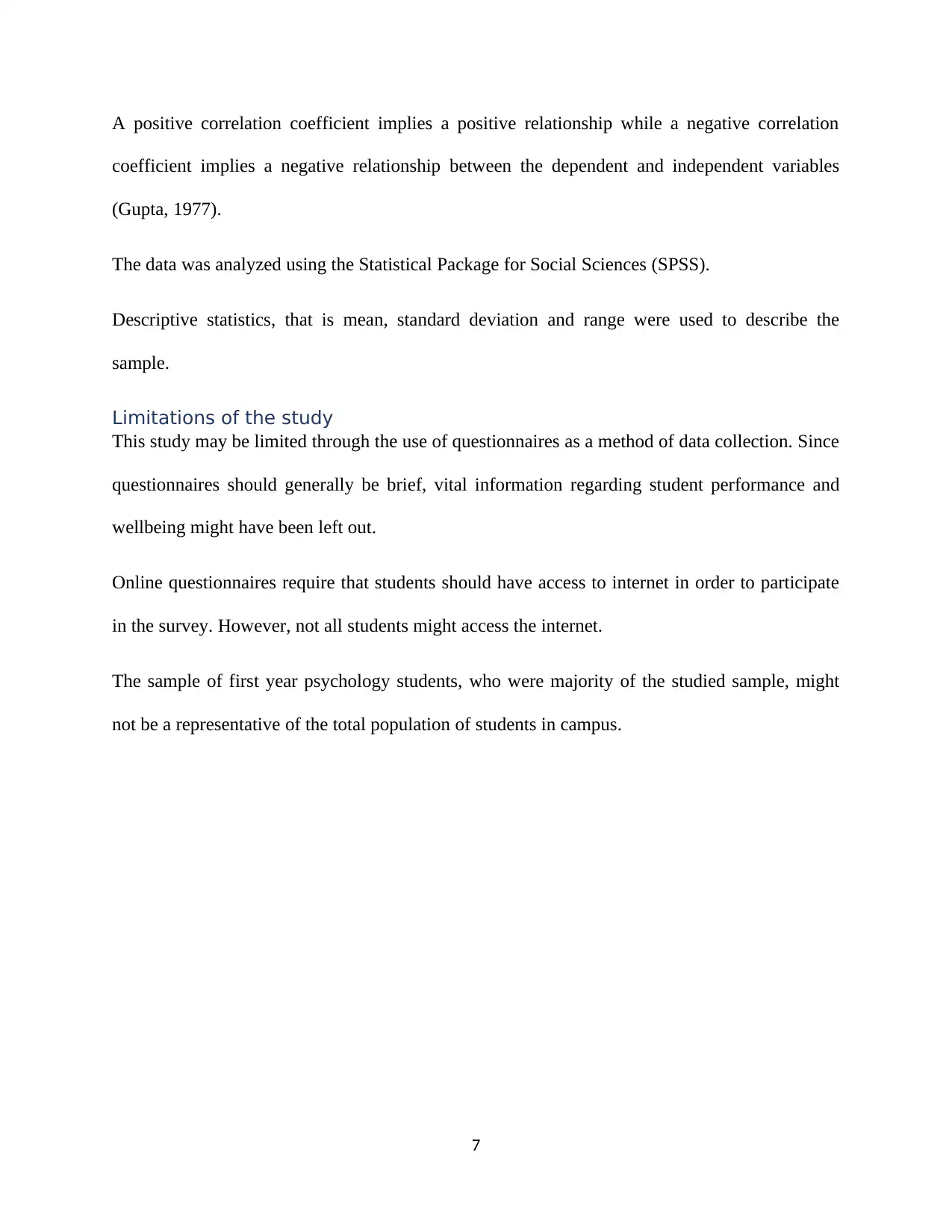
A positive correlation coefficient implies a positive relationship while a negative correlation
coefficient implies a negative relationship between the dependent and independent variables
(Gupta, 1977).
The data was analyzed using the Statistical Package for Social Sciences (SPSS).
Descriptive statistics, that is mean, standard deviation and range were used to describe the
sample.
Limitations of the study
This study may be limited through the use of questionnaires as a method of data collection. Since
questionnaires should generally be brief, vital information regarding student performance and
wellbeing might have been left out.
Online questionnaires require that students should have access to internet in order to participate
in the survey. However, not all students might access the internet.
The sample of first year psychology students, who were majority of the studied sample, might
not be a representative of the total population of students in campus.
7
coefficient implies a negative relationship between the dependent and independent variables
(Gupta, 1977).
The data was analyzed using the Statistical Package for Social Sciences (SPSS).
Descriptive statistics, that is mean, standard deviation and range were used to describe the
sample.
Limitations of the study
This study may be limited through the use of questionnaires as a method of data collection. Since
questionnaires should generally be brief, vital information regarding student performance and
wellbeing might have been left out.
Online questionnaires require that students should have access to internet in order to participate
in the survey. However, not all students might access the internet.
The sample of first year psychology students, who were majority of the studied sample, might
not be a representative of the total population of students in campus.
7
⊘ This is a preview!⊘
Do you want full access?
Subscribe today to unlock all pages.

Trusted by 1+ million students worldwide
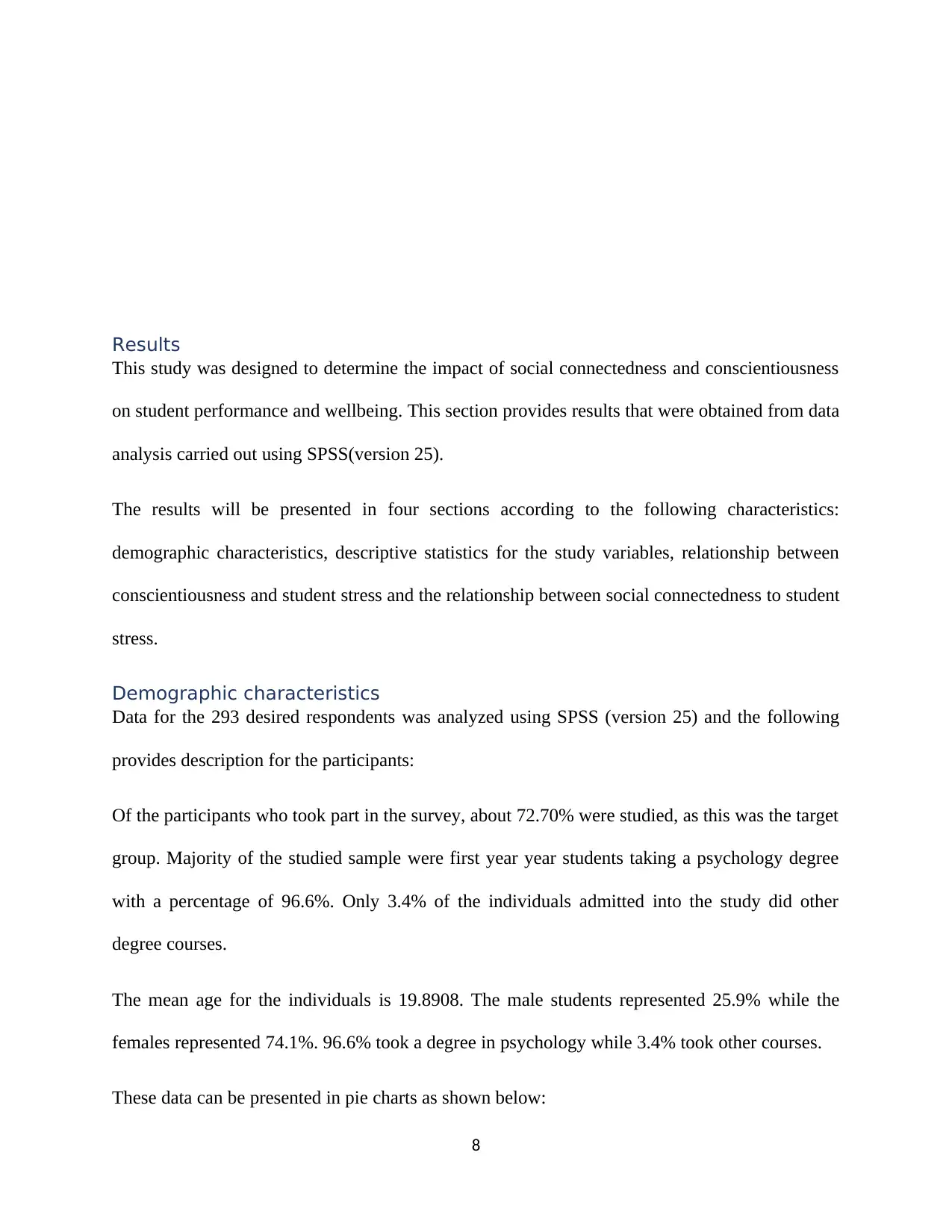
Results
This study was designed to determine the impact of social connectedness and conscientiousness
on student performance and wellbeing. This section provides results that were obtained from data
analysis carried out using SPSS(version 25).
The results will be presented in four sections according to the following characteristics:
demographic characteristics, descriptive statistics for the study variables, relationship between
conscientiousness and student stress and the relationship between social connectedness to student
stress.
Demographic characteristics
Data for the 293 desired respondents was analyzed using SPSS (version 25) and the following
provides description for the participants:
Of the participants who took part in the survey, about 72.70% were studied, as this was the target
group. Majority of the studied sample were first year year students taking a psychology degree
with a percentage of 96.6%. Only 3.4% of the individuals admitted into the study did other
degree courses.
The mean age for the individuals is 19.8908. The male students represented 25.9% while the
females represented 74.1%. 96.6% took a degree in psychology while 3.4% took other courses.
These data can be presented in pie charts as shown below:
8
This study was designed to determine the impact of social connectedness and conscientiousness
on student performance and wellbeing. This section provides results that were obtained from data
analysis carried out using SPSS(version 25).
The results will be presented in four sections according to the following characteristics:
demographic characteristics, descriptive statistics for the study variables, relationship between
conscientiousness and student stress and the relationship between social connectedness to student
stress.
Demographic characteristics
Data for the 293 desired respondents was analyzed using SPSS (version 25) and the following
provides description for the participants:
Of the participants who took part in the survey, about 72.70% were studied, as this was the target
group. Majority of the studied sample were first year year students taking a psychology degree
with a percentage of 96.6%. Only 3.4% of the individuals admitted into the study did other
degree courses.
The mean age for the individuals is 19.8908. The male students represented 25.9% while the
females represented 74.1%. 96.6% took a degree in psychology while 3.4% took other courses.
These data can be presented in pie charts as shown below:
8
Paraphrase This Document
Need a fresh take? Get an instant paraphrase of this document with our AI Paraphraser
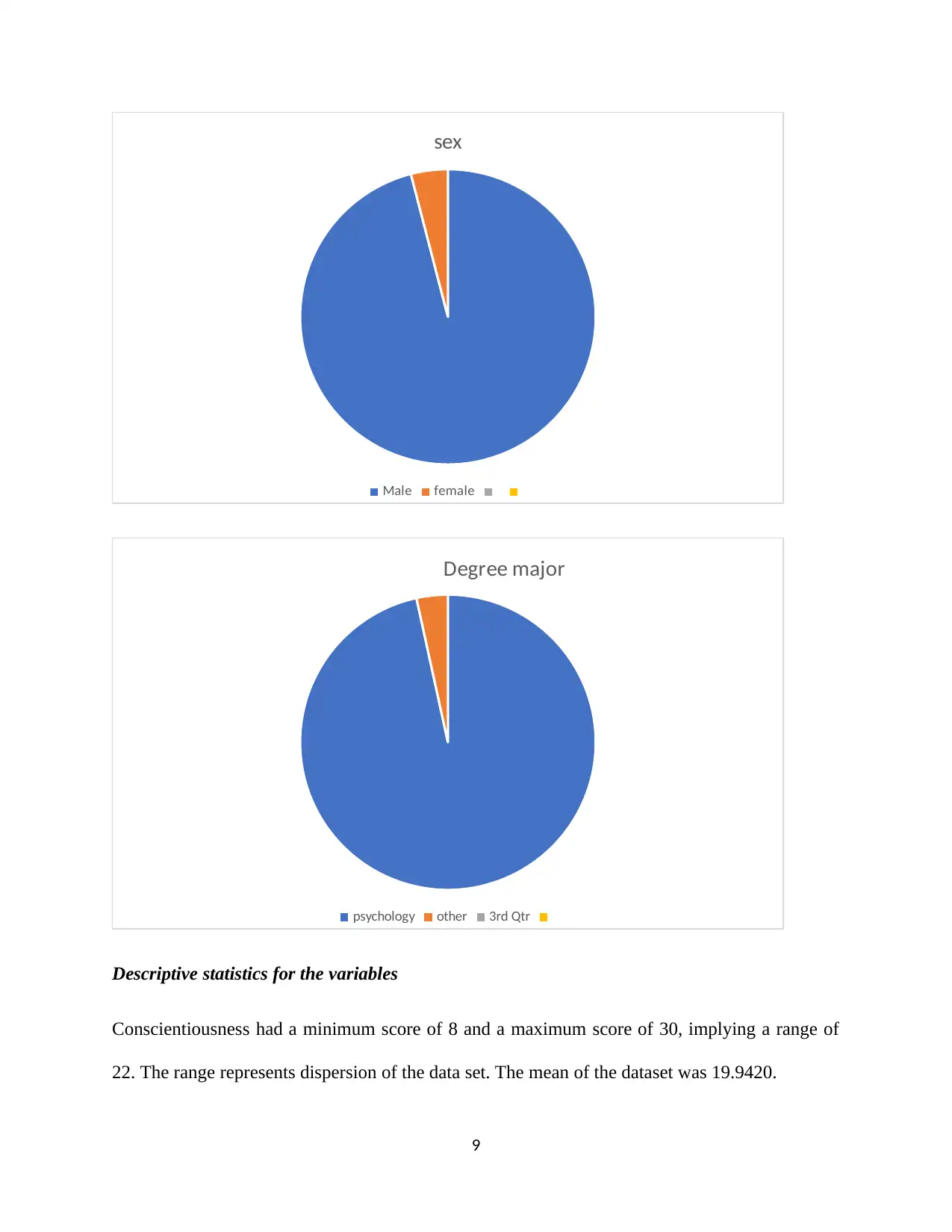
sex
Male female
Degree major
psychology other 3rd Qtr
Descriptive statistics for the variables
Conscientiousness had a minimum score of 8 and a maximum score of 30, implying a range of
22. The range represents dispersion of the data set. The mean of the dataset was 19.9420.
9
Male female
Degree major
psychology other 3rd Qtr
Descriptive statistics for the variables
Conscientiousness had a minimum score of 8 and a maximum score of 30, implying a range of
22. The range represents dispersion of the data set. The mean of the dataset was 19.9420.
9
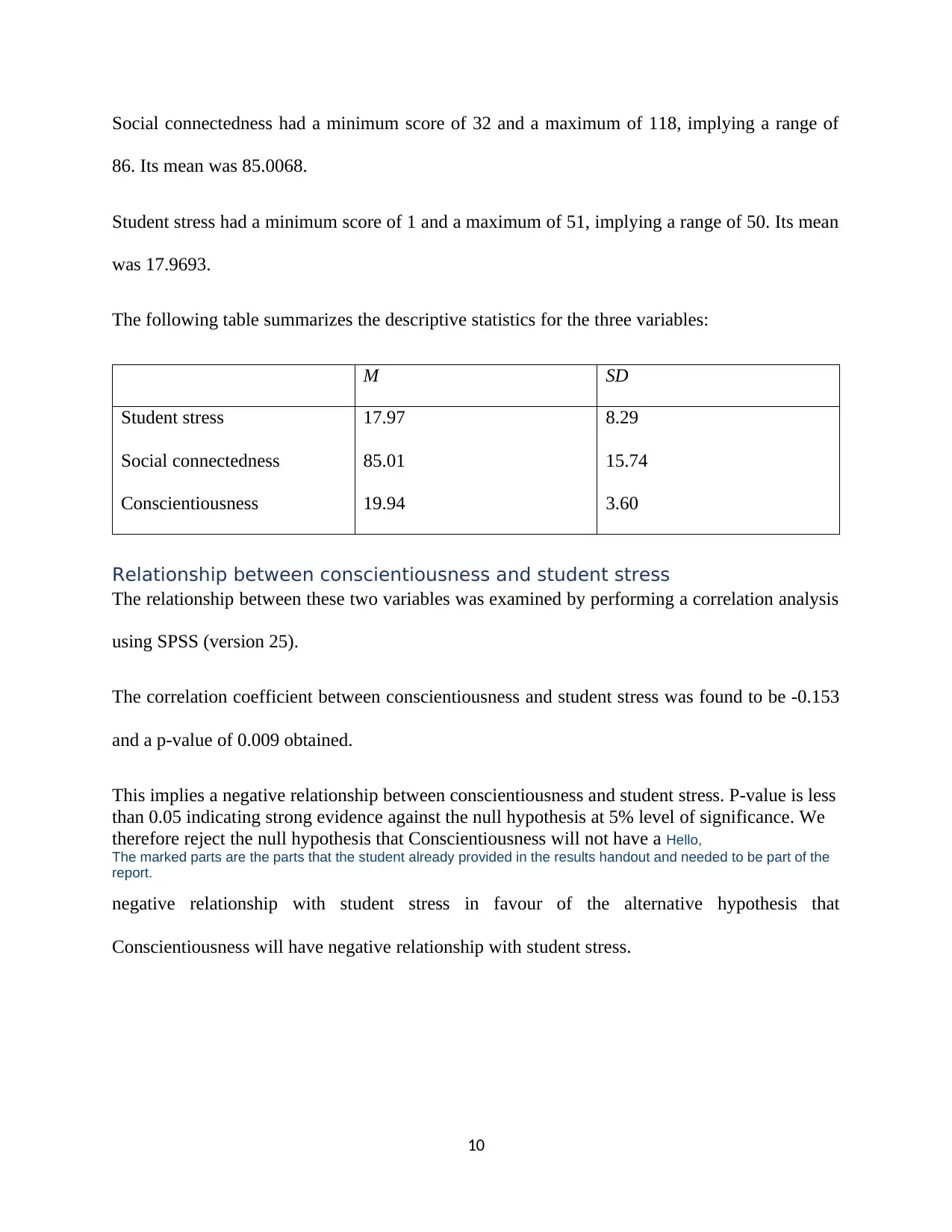
Social connectedness had a minimum score of 32 and a maximum of 118, implying a range of
86. Its mean was 85.0068.
Student stress had a minimum score of 1 and a maximum of 51, implying a range of 50. Its mean
was 17.9693.
The following table summarizes the descriptive statistics for the three variables:
M SD
Student stress
Social connectedness
Conscientiousness
17.97
85.01
19.94
8.29
15.74
3.60
Relationship between conscientiousness and student stress
The relationship between these two variables was examined by performing a correlation analysis
using SPSS (version 25).
The correlation coefficient between conscientiousness and student stress was found to be -0.153
and a p-value of 0.009 obtained.
This implies a negative relationship between conscientiousness and student stress. P-value is less
than 0.05 indicating strong evidence against the null hypothesis at 5% level of significance. We
therefore reject the null hypothesis that Conscientiousness will not have a Hello,
The marked parts are the parts that the student already provided in the results handout and needed to be part of the
report.
negative relationship with student stress in favour of the alternative hypothesis that
Conscientiousness will have negative relationship with student stress.
10
86. Its mean was 85.0068.
Student stress had a minimum score of 1 and a maximum of 51, implying a range of 50. Its mean
was 17.9693.
The following table summarizes the descriptive statistics for the three variables:
M SD
Student stress
Social connectedness
Conscientiousness
17.97
85.01
19.94
8.29
15.74
3.60
Relationship between conscientiousness and student stress
The relationship between these two variables was examined by performing a correlation analysis
using SPSS (version 25).
The correlation coefficient between conscientiousness and student stress was found to be -0.153
and a p-value of 0.009 obtained.
This implies a negative relationship between conscientiousness and student stress. P-value is less
than 0.05 indicating strong evidence against the null hypothesis at 5% level of significance. We
therefore reject the null hypothesis that Conscientiousness will not have a Hello,
The marked parts are the parts that the student already provided in the results handout and needed to be part of the
report.
negative relationship with student stress in favour of the alternative hypothesis that
Conscientiousness will have negative relationship with student stress.
10
⊘ This is a preview!⊘
Do you want full access?
Subscribe today to unlock all pages.

Trusted by 1+ million students worldwide
1 out of 17
Related Documents
Your All-in-One AI-Powered Toolkit for Academic Success.
+13062052269
info@desklib.com
Available 24*7 on WhatsApp / Email
![[object Object]](/_next/static/media/star-bottom.7253800d.svg)
Unlock your academic potential
Copyright © 2020–2025 A2Z Services. All Rights Reserved. Developed and managed by ZUCOL.





